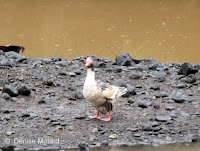MUSCOVY DUCK
MUSCOVY DUCK (Cairina moschata) – (See images below)
DESCRIPTION: The Muscovy duck looks different than what one would expect to see in a duck. What makes this duck distinctive are the red wattles around the bill, more prominent in the male. It is a large duck, with the male noticeably larger than the female. The wild species is generally black with white patches. The bill is usually black. These ducks have claws on their feet, which are dark. Females lack the wattles. Plumage color varies and can be largely white. Its length is approximately 30 inches long (76 cm).
VOICE: https://www.xeno-canto.org/species/Cairina-moschata . This is not a quacking duck, and it is less noisy than quacking species like the Mallard for example.
NAME: There are several explanations for the English name ‘Muscovy’ for this duck species, but none is confirmed. The English name ‘duck’ means ‘diver’. The Latin genus name ‘Cairina’ stems from Cairo, Egypt, in the mistaken belief that thus duck originated from there. As for the Latin species name ‘moschata’, it means ‘musky’, in reference to the musk odour of this duck (hence the French name ‘Canard musqué).
HABITAT: Wet forests, lakes, wetlands near agricultural fields.
DIET: Plant material in shallow water, insects, crustaceans and molluscs.
BREEDING/NESTING: The male is territorial and can be aggressive. Around a dozen white eggs are laid. The female cares for them most of the time for a few months, but the male also provides food and protects them.
DISTRIBUTION: Muscovy ducks are native to Mexico as well as Central and the northern part of South America. The species is non-migratory. They have been introduced in many parts of the world including states in the USA, notably Hawaii. In spite of the normal range of this duck being in tropical and subtropical regions, it can adjust to temperate climates too.
CONSERVATION: This duck is widely hunted in its native range. However due to it being widespread it is not yet considered at risk.
NOTES: This species has been domesticated for centuries and now feral birds are mixed with the wild ones. In the USA, it is considered an invasive species and people can keep them for food only, not hunting. The muscovy ducks seen below at Waimea Valley were likely domestic fowl.
REFERENCES: https://en.wikipedia.org/wiki/Muscovy_duck
https://www.allaboutbirds.org/guide/Muscovy_Duck/overview
https://hedgecombers.com/muscovy-duck/
https://identify.whatbird.com/obj/1010/overview/Muscovy_Duck.aspx
https://www.thespruce.com/muscovy-duck-profile-386369
The muscovy duck shown below was resting along the Waimea River on Oahu:
This other muscovy duck was filmed during a rain at Waimea Valley, Oahu:
DESCRIPTION: The Muscovy duck looks different than what one would expect to see in a duck. What makes this duck distinctive are the red wattles around the bill, more prominent in the male. It is a large duck, with the male noticeably larger than the female. The wild species is generally black with white patches. The bill is usually black. These ducks have claws on their feet, which are dark. Females lack the wattles. Plumage color varies and can be largely white. Its length is approximately 30 inches long (76 cm).
VOICE: https://www.xeno-canto.org/species/Cairina-moschata . This is not a quacking duck, and it is less noisy than quacking species like the Mallard for example.
NAME: There are several explanations for the English name ‘Muscovy’ for this duck species, but none is confirmed. The English name ‘duck’ means ‘diver’. The Latin genus name ‘Cairina’ stems from Cairo, Egypt, in the mistaken belief that thus duck originated from there. As for the Latin species name ‘moschata’, it means ‘musky’, in reference to the musk odour of this duck (hence the French name ‘Canard musqué).
HABITAT: Wet forests, lakes, wetlands near agricultural fields.
DIET: Plant material in shallow water, insects, crustaceans and molluscs.
BREEDING/NESTING: The male is territorial and can be aggressive. Around a dozen white eggs are laid. The female cares for them most of the time for a few months, but the male also provides food and protects them.
DISTRIBUTION: Muscovy ducks are native to Mexico as well as Central and the northern part of South America. The species is non-migratory. They have been introduced in many parts of the world including states in the USA, notably Hawaii. In spite of the normal range of this duck being in tropical and subtropical regions, it can adjust to temperate climates too.
CONSERVATION: This duck is widely hunted in its native range. However due to it being widespread it is not yet considered at risk.
NOTES: This species has been domesticated for centuries and now feral birds are mixed with the wild ones. In the USA, it is considered an invasive species and people can keep them for food only, not hunting. The muscovy ducks seen below at Waimea Valley were likely domestic fowl.
REFERENCES: https://en.wikipedia.org/wiki/Muscovy_duck
https://www.allaboutbirds.org/guide/Muscovy_Duck/overview
https://hedgecombers.com/muscovy-duck/
https://identify.whatbird.com/obj/1010/overview/Muscovy_Duck.aspx
https://www.thespruce.com/muscovy-duck-profile-386369
 |
| Muscovy duck, Waimea Valley, Oahu |
 |
| Muscovy duck, Waimea Valley, Oahu |
 |
| Muscovy duck resting, Waimea Valley |
This other muscovy duck was filmed during a rain at Waimea Valley, Oahu: